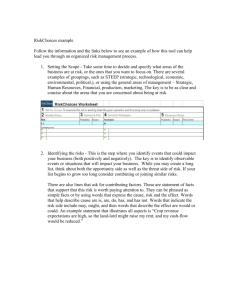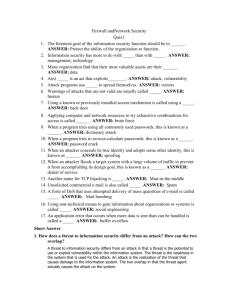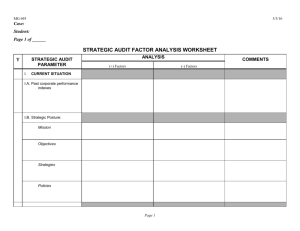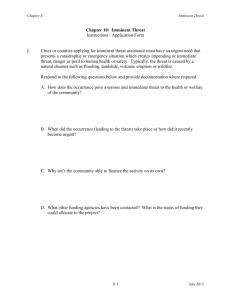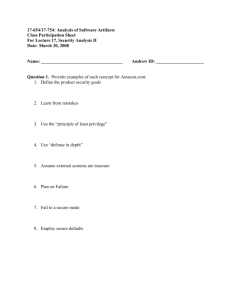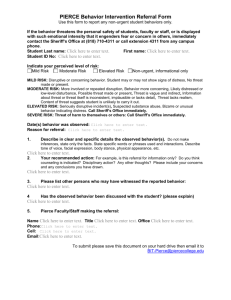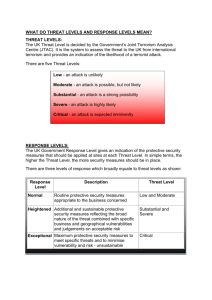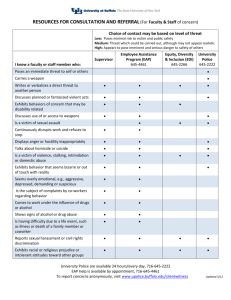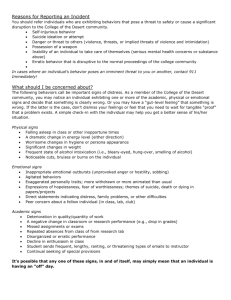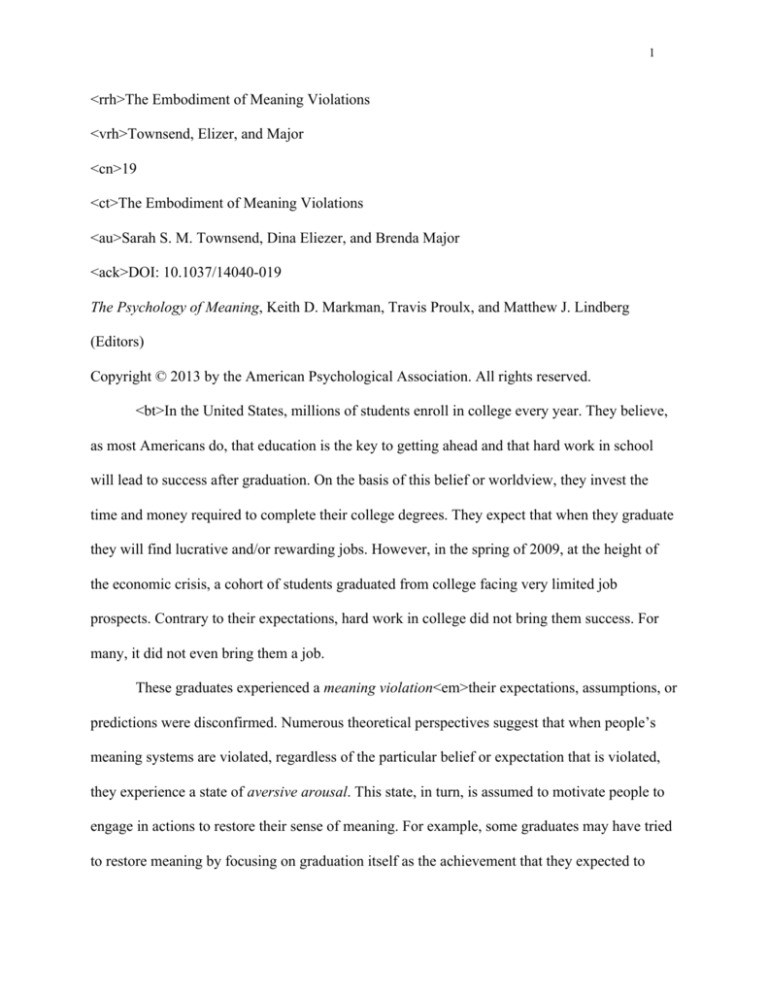
1
<rrh>The Embodiment of Meaning Violations
<vrh>Townsend, Elizer, and Major
<cn>19
<ct>The Embodiment of Meaning Violations
<au>Sarah S. M. Townsend, Dina Eliezer, and Brenda Major
<ack>DOI: 10.1037/14040-019
The Psychology of Meaning, Keith D. Markman, Travis Proulx, and Matthew J. Lindberg
(Editors)
Copyright © 2013 by the American Psychological Association. All rights reserved.
<bt>In the United States, millions of students enroll in college every year. They believe,
as most Americans do, that education is the key to getting ahead and that hard work in school
will lead to success after graduation. On the basis of this belief or worldview, they invest the
time and money required to complete their college degrees. They expect that when they graduate
they will find lucrative and/or rewarding jobs. However, in the spring of 2009, at the height of
the economic crisis, a cohort of students graduated from college facing very limited job
prospects. Contrary to their expectations, hard work in college did not bring them success. For
many, it did not even bring them a job.
These graduates experienced a meaning violation<em>their expectations, assumptions, or
predictions were disconfirmed. Numerous theoretical perspectives suggest that when people’s
meaning systems are violated, regardless of the particular belief or expectation that is violated,
they experience a state of aversive arousal. This state, in turn, is assumed to motivate people to
engage in actions to restore their sense of meaning. For example, some graduates may have tried
to restore meaning by focusing on graduation itself as the achievement that they expected to
2
attain through their hard work (i.e., assimilation). Others may have modified their belief system
to include the idea that factors other than hard work will influence who is successful (i.e.,
accommodation). Yet, other students may have affirmed an unrelated source of meaning in their
lives, such as their belief in God (i.e., compensation; e.g., Heine, Proulx, & Vohs, 2006; see also
Chapter 4, this volume). Engaging in these meaning-restoring actions, in turn, is assumed to
alleviate the state of aversive arousal (Festinger, 1957; Heine et al., 2006). Thus, this state plays
a central and causal role in the chain of events from meaning violation to meaning restoration
and is a common thread among theories positing a motivation to maintain one’s sense of
meaning.
Despite the important role aversive arousal may play in meaning maintenance, this state
remains relatively unspecified and difficult to measure. We define aversive arousal as the
psychological experience of anxiety or threat and its embodiment, that is, the accompanying
physiological responses. In this chapter, we describe measures of peripheral physiological
responses that provide means of indexing this state, and we review research that has used these
measures to demonstrate links in the causal chain from meaning violation to threat to meaning
restoration and reduced threat. Using this definition and measurement of aversive arousal allows
us to take into account findings from work on several forms of meaning violations and helps to
reveal areas in which additional research is needed to establish the entire causal chain.
This chapter consists of three sections. In the first section, we briefly review the meaning
violation literature and then elaborate on our definition of aversive arousal as threat and explain
the specific physiological responses that can be measured to index the psychological experience
of threat. In the second section, we review research using peripheral physiological measures that
has demonstrated each link in the causal chain from meaning violations to threat to meaning
3
restoration and decreased threat. Specifically, we review evidence that (a) meaning violations
trigger threat, (b) threat leads to meaning restoration attempts, and (c) threat is dampened when
meaning restoration takes place. Whereas extensive research has shown that meaning violations
of various forms are followed by attempts to restore meaning, relatively little work has directly
examined the experience of aversive arousal as a response to meaning violations and/or as a
cause or motivator of meaning restoration. Finally, we summarize and conclude with a
discussion of the gaps that exist in the current literature and suggest how peripheral physiological
measures can be used in future work to establish the entire causal chain.
<h1>Meaning Violations
<bt>We adopt a broad definition of meaning as a set of mental representations of the
expected relationships or associations connecting people, places, objects, and beliefs to each
other (e.g., Baumeister, 1991; Heine et al., 2006; McGregor & Little, 1998). This
conceptualization of meaning includes both explicit and implicit expected associations and
encompasses many related concepts, such as worldviews (e.g., Major, Kaiser, O’Brien, &
McCoy, 2007), folk psychologies (Bruner, 1990), system-relevant ideologies (Jost & Banaji,
1994), cultural models (e.g., Fiske, Kitayama, Markus, & Nisbett, 1998), and self-schemas (e.g.,
Markus, 1977). Meaning serves as a lens through which people view and interpret the world,
provides guidelines for how people should behave in various situations, helps people cope with
traumatic life and events, and even buffers people from existential terror. Thus, meaning
provides individuals with expectations for themselves, others, and the world around them, and
maintaining a sense of meaning has been argued to possibly be a “fundamental human need”
(see, e.g., Chapter 11, this volume).
4
The meaning frameworks that people hold, however, are imperfect reflections of reality.
Interactions, information, or events, whether they are consciously perceived or outside of
people’s awareness, can violate people’s sense of meaning. For example, witnessing an innocent
victim suffer violates just world expectations (Lerner, 1980), or encountering an Asian American
who speaks with a Southern accent violates category-based expectations (stereotypes; e.g.,
Mendes, Blascovich, Hunter, Lickel, & Jost, 2007). Violations can intimately involve the self,
such as when an individual’s expectations about his or her own abilities are disconfirmed by
inconsistent feedback (e.g., Ayduk, Gyurak, Akinola, & Mendes, 2011), or they can be relatively
unrelated to the self, such as when an individual’s expectations about the colors of playing card
suits are disconfirmed by a doctored deck of cards (Proulx & Major, 2011). Meaning violations
do not only occur when people encounter unexpected negative information; people can also have
their sense of meaning violated by positive information (e.g., Plaks, Grant, & Dweck, 2005; see
also Chapter 6, this volume).
Given individuals’ need for meaning, many theories propose that violations of meaning
systems lead to a state of aversive arousal, which then prompts individuals to restore their sense
of meaning as a way to reduce the aversive state (e.g., Festinger, 1957; Proulx, Heine, & Vohs,
2010; Sherman & Cohen, 2006; see also Chapter 20, this volume). For instance, cognitive
dissonance leads to psychological discomfort, which motivates people to restore meaning (e.g.,
Elliot & Devine, 1994; Galinsky, Stone, & Cooper, 2000). Similarly, personal uncertainty is
experienced as an aversive or uncomfortable feeling, which motivates people to restore their
sense of meaning and certainty (e.g., Van den Bos, 2009). In integrating across these various
theories, Proulx and Heine (2010) argued that violations of one’s sense of meaning lead to a
unique arousal state, which motivates attempts to restore meaning. However, this unique,
5
aversive arousal state is relatively unspecified and difficult to assess with self-report measures.
For example, asking participants who are experiencing cognitive dissonance to report their
degree of psychological discomfort can have the unintended effect of providing them with a way
to reduce dissonance or restore meaning (e.g., Galinsky et al., 2000). In the section that follows,
we explain our definition of this unique arousal state as threat and discuss how this experience
may be embodied and therefore measured by several physiological indexes.
<h1>Aversive Arousal as Threat: Physiological Indexes
<bt>The psychological experience of threat occurs when individuals appraise the
demands of their current situation as exceeding their resources to cope with those demands (e.g.,
Blascovich, 2008; Lazarus, 1966). Meaning violations heighten situational demands by
increasing unpredictability and perceptions of uncertainty. For instance, during an interpersonal
interaction, being unsure of how to behave or what to expect of one’s interaction partner will
make that interaction more difficult. As a result, when individuals encounter information, events,
or people who violate their sense of meaning, they should experience threat.
Attempts to index threat with self-report measures have often been unsuccessful. Selfreports are vulnerable to self-presentational concerns and depend on individuals’ conscious
awareness (e.g., Matheson & Cole, 2004). However, the psychological experience of threat is
embodied and can be indexed by measuring physiological responses. These measures offer a way
to directly index the threat that is triggered by meaning violations and offer several advantages
over self-report data. Indexing threat with physiological responses circumvents potential
distortions or omissions that might be present in self-reports and has the advantages of being
covert, continuous, and on-line (Blascovich & Mendes, 2010).
6
Broadly speaking, physiological responses can be divided into (a) central
neurophysiological processes that are assessed by measuring activity in the brain and (b)
peripheral neurophysiological processes that are assessed by measuring activity in the visceral,
somatic, and endocrine systems. Of course, both central and peripheral measures offer unique
advantages and present unique challenges (for a review, see Blascovich, Vanman, Mendes, &
Dickerson, 2011). We focus on measures of peripheral physiological responses that are
associated with the psychological experience of threat. These measures have the practical
advantage of being less costly to collect and the methodological advantage of being less intrusive
and allowing for data collection while participants are in more ecologically valid situations,
including field settings.
Peripheral physiological responses can index activation of the two primary biological
systems that are active during affective and cognitive processes<em>the sympathetic adrenal
medullary (SAM) and hypothalamic<en>pituitary<en>adrenal cortical (HPA) axes (Blascovich
& Mendes, 2010). Of particular relevance here, both the SAM and HPA axes are activated by the
experience of stress or threat. The SAM system responds quickly during fight-or-flight
situations, whereas the HPA system activates after longer experiences of threat or stress. SAM
activation triggers the release of epinephrine from the adrenal medulla, which has the effect of
increasing heart rate, blood pressure, and skin conductance; decreasing the preejection period
(i.e., the time between the initiation of the cardiac cycle and the opening of the aortic valve);
dilating pupils; and inhibiting the gastrointestinal tract. These responses have the downstream
effects of increasing energy, alertness, and blood flow to the muscles. HPA activation sets off a
chain of reactions beginning with the release of corticotropin-releasing hormone by the
hypothalamus, which triggers the anterior pituitary to release adrenocorticotropin hormone,
7
which stimulates an area of the adrenal cortex to release cortisol. Cortisol is important for coping
with prolonged experiences of stress because it helps to increase energy or fuel that is available
by elevating the level of glucose in the blood. Although both SAM and HPA activation help
individuals respond to and cope with physical stressors, they are often triggered by the
experience of psychological stress or threat, such as public speaking or thinking about one’s
mortality (Sapolsky, 2004).
Common peripheral physiological measures of SAM activation include changes in heart
rate, blood pressure, and skin conductance. Increases in these individual physiological responses
indicate heightened arousal, and measuring these responses provides a way to roughly index the
psychological experience of threat. However, because these measures only indicate a general
state of heightened arousal, they do not have a one-to-one correspondence with the specific
psychological state of threat (Blascovich & Kelsey, 1990; Cacioppo, Tassinary, & Berntson,
2007). Measuring these responses may indicate an experience of threat, but it may also indicate
more affectively neutral or even positive arousal. Nonetheless, these measures may serve as a
useful approximation of threat because they are relatively easy to administer and because they
can measure arousal in passive and active situations.
HPA activation is often assessed by measuring increases in cortisol and can be used as an
index of prolonged threat (Dickerson & Kemeny, 2004). In particular, Dickerson and Kemeny
(2004) argued that cortisol is released when people’s central goals are threatened as part of an
adaptive response to increase available energy to deal with, and it is hoped reduce, the threat.
These central goals include the preservation of individuals’ physical and social selves and, we
argue, the preservation of individuals’ sense of meaning. Although cortisol may offer more
precision in indexing the psychological state of threat, this measure is not without its limitations.
8
Specifically, increases in cortisol are most reliably found when individuals are in situations, such
as cognitive tasks or verbal interaction tasks, that are goal relevant and engender some degree of
evaluation, that is, motivated performance situations. Thus, cortisol responses may not provide a
reliable index of threat when participants are engaged in more passive tasks.
The biospychosocial (BPS) model of challenge and threat has identified and validated
specific patterns of cardiovascular responses, indicating SAM and HPA activation, which index
the psychological states of threat versus challenge (see Blascovich, 2008, for a review). Threat
occurs when individuals appraise situational demands as outweighing their appraisal of their
personal resources, the definition we mentioned previously. Conversely, challenge occurs when
individuals appraise their resources as exceeding demands.
Both challenge and threat states are associated with activation of the SAM axis; however,
activation of the HPA axis is greater during threat than challenge. Specifically, challenge states
are characterized by greater cardiac responses and lower vascular responses. In contrast, threat
states are characterized by greater vascular responses relative to cardiac responses. Thus, threat,
relative to challenge, is indexed by lower cardiac output and greater systemic vascular resistance,
which is measured as total peripheral resistance. The threat response results in a constriction of
arteries, whereas the challenge response functions to increase blood flow to skeletal muscles and
dilate arteries to accommodate this blood. As with indexing threat by measuring changes in
cortisol, these physiological indexes of the psychological states of threat and challenge have only
been validated for situations in which individuals are in motivated performance situations.
The physiological measures described represent promising ways to index the threat that
accompanies meaning violations. Measures of cortisol or the pattern of cardiovascular responses
outlined in the BPS model provide more specific indexes of threat but are limited to situations in
9
which people are engaged in active coping tasks, which may not cover the range of experiences
of meaning violations. Single measures of SAM activation such as blood pressure and skin
conductance can serve as rough indexes of threat. Although these measures lack specificity, they
may be useful in common meaning violation paradigms, which use more passive coping
situations (i.e., participants are exposed to an unexpected event or asked to write about
uncertainty or mortality). Overall, we believe that under the right conditions, peripheral
physiological measures can be successfully adapted to meaning threat paradigms.
In the next three sections, we discuss how physiological measures have been or could be
integrated with meaning violation research to explore the full causal chain from meaning
violations to threat to meaning restoration.
<h1>The First Link: Meaning Violations Trigger Threat
<bt>Next, we review evidence for the first link in the chain, that meaning violations
trigger threat. These studies are important for both theoretical and methodological reasons.
Theoretically, these studies demonstrate that different types of meaning violations, including
uncertainty (e.g., Van den Bos, 2009), dissonance (e.g., Croyle & Cooper, 1983; Elkin & Leippe,
1986), and expectancy (e.g., Major et al., 2007; Mendes et al., 2007), lead to a common set of
physiological responses. Methodologically, these studies provide examples of how meaning
violation paradigms can be integrated with physiological measurement techniques.
<h2>Uncertainty Triggers Threat
<bt>The experience of uncertainty, particularly uncertainty about one’s understanding of
the self, the world, or the relationship between the two (Van den Bos, 2009) is one type of
meaning violation. Being unable to predict one’s surroundings, such as when certain stimuli will
occur or how another person will behave, may make individuals feel uncertain in that situation.
10
As with other meaning violations, personal uncertainty is experienced as an aversive or
uncomfortable feeling (e.g., Hogg, 2007; Van den Bos, 2009). Through the examination of these
types of situations, the following research makes the important direct link between uncertainty
and threat as measured by several different physiological indicators.
First, the experience of uncertainty due to unpredictability is associated with greater
SAM activation (Jennings, Averill, Opton, & Lazarus, 1970; Monat, Averill, & Lazarus, 1972).
For example, Jennings and colleagues (1970) gave participants a signal that indicated, with
varying degrees of certainty, that they would receive a shock. When the signal was played,
participants who were uncertain about whether they would receive a shock showed the greatest
increase in heart rate<em>even greater than those who were certain that they would receive a
shock. Monat and colleagues (1972) replicated these findings, showing a similar pattern for
threat in response to uncertainty as indicated by greater galvanic skin response.
Individual differences in the extent to which people perceive uncertainty as stressful also
contribute to the threat-related arousal people experience in unpredictable situations.
Specifically, Greco and Roger (2003) measured the extent to which participants reported that
being uncertain was stressful and then exposed them to distressing stimuli at times that they were
either able or unable to predict. Participants who reported that they experienced stress from
uncertainty and those who were unable to predict when they would be exposed to the distressing
stimulus had the highest blood pressure responses.
Work on intergroup interactions also provides evidence that uncertainty is threatening
(e.g., Blascovich, Mendes, Hunter, Lickel, & Kowai-Bell, 2001; Mendes, Blascovich, Lickel, &
Hunter, 2002). Compared with interactions between individuals who are members of the same
social group (e.g., two White Americans), interactions between individuals who are members of
11
different social groups are characterized by greater uncertainty (e.g., Vorauer, 2006). Given this
greater uncertainty, intergroup interactions should lead to greater aversive arousal or threat than
intragroup interactions. Indeed, Blascovich et al. (2001) found that nonstigmatized people (e.g.,
people without facial birthmarks, White Americans) showed cardiovascular reactivity patterns
consistent with threat when they interacted with members of a stigmatized outgroup (e.g., people
with facial birthmarks, Black Americans). In addition, people who reported having had more
contact with Black Americans were less threatened during these intergroup interactions
presumably because the additional experience led them to feel more certain about how the
interaction would proceed.
Uncertainty, in the form of uncontrollability, has also been associated with increased
threat as indexed by heightened cortisol levels (e.g., Dickerson & Kemeny, 2004). In their metaanalysis, Dickerson and Kemeny (2004) found that people who are engaged in uncontrollable
tasks show larger cortisol responses than those who are engaged in controllable tasks. In
particular, it seems to be the knowledge or perception that a desired outcome is not contingent on
one’s behavior that leads to increases in cortisol. This experience is largely consistent with
meaning violations. One key function of meaning is to provide people with a sense of
predictability and control over outcomes. Thus, meaning violations may lead people to feel that
they are unable to predict or control their outcomes. The findings reported by Dickerson and
Kemeny provide suggestive evidence that meaning violations trigger threat as indexed by
cortisol.
<h2>Dissonance Triggers Threat
<bt>Another type of meaning violation is cognitive dissonance, which is experienced
when individuals perceive a logical inconsistency between their thoughts and/or their behavior
12
(Festinger, 1957). For example, a college student who believes that tuition should remain stable
and also believes he or she has freely chosen to write an essay in support of a tuition increase
will experience dissonance. The following research demonstrates the direct link between
dissonance and threat as measured by several different physiological indicators.
In one of the first studies to assess physiological responses to dissonance, Gerard (1967)
examined participants’ finger pulse amplitude in response to a spreading of alternatives
paradigm. In this study, participants were asked to select between two paintings. In one
condition, one of the paintings was strongly preferred over the other; however, in the second
condition, the two paintings were equally liked. Dissonance was presumed to arise in the latter
condition because there was an inconsistency between individuals’ choice of the selected
painting and their liking for the unselected painting. Of participants who were forced to choose
between two similar alternatives, those experiencing greater dissonance showed greater
decreases in finger pulse amplitude, which indicates greater vasoconstriction.
Subsequent studies replicated this finding using skin conductance responses as a measure
of threat (Croyle & Cooper, 1983; Elkin & Leippe, 1986; Losch & Cacioppo, 1990). For
example, Robinson and Demaree (2007) examined responses to expressive dissonance, when an
individual’s emotional expression is inconsistent with his or her actual emotional state. While
watching sad film clips, participants in one condition were allowed to express their emotions
naturally; however, those in a second condition were asked to express the opposite of their true
feelings, inducing expressive dissonance. Participants in the expressive dissonance condition
showed greater skin conductance responses, indicating greater threat.
<h2>Violation of Expectancies Triggers Threat
13
<bt>Expectancy violations are another type of meaning violation and have been linked to
the experience of threat. This research, reviewed in the section that follows, also makes the
important contribution of demonstrating that a range of expectancy violations trigger threat.
<h3>Violation of Self-Image-Based Expectancies
<bt>Self-verification theory proposes that people are motivated to maintain a consistent
self-concept and want others to see them in ways that are consistent with their views of
themselves (e.g., Swann, Rentfrow, & Guinn, 2002). Even when people have negative selfconceptions, they often desire to interact with people who confirm their negative self-image (for
a review, see Swann, 2012). However, people are not always able to obtain verifying feedback
from others. Instead, they often receive feedback that is inconsistent with their self-view, which
may violate their sense of meaning. A recent study by Ayduk et al. (2011) provided the most
direct evidence that violations of one’s self-views elicit threat as indexed by blood pressure
reactivity. Participants with high and low self-esteem were given feedback that was either
positive or negative and, therefore, consistent or inconsistent with their self-views. Among
people with low self-esteem, positive (i.e., inconsistent) feedback led to marginally higher blood
pressure reactivity than negative (i.e., consistent) feedback. The same pattern was found for
people with high self-esteem; negative (i.e., inconsistent) feedback led to greater blood pressure
reactivity than positive (i.e., consistent) feedback.
<h3>Violation of Worldview-Based Expectancies
<bt>Meaning violations can also occur when people’s worldviews are disconfirmed
(Major et al., 2007). A worldview is a set of implicit and explicit assumptions about oneself, the
world, and one’s place in the world. Worldviews provide people with expectations for
themselves and others. In worldview verification theory, Major and colleagues (2007) argued
14
that people are motivated to maintain consistency between their worldview and their experiences
and that experiences that are inconsistent with an individual’s worldview constitute a meaning
violation.
Research on worldview verification has examined one central component of people’s
worldviews: their beliefs about and explanations for status inequality in society, that is, their
status ideology. In the United States the dominant status ideology is meritocracy, which holds
that hard work and ability lead to success and that the status system is fair (O’Brien & Major,
2005). Like other components of a person’s worldview, meritocracy beliefs guide perceptions
and expectations, including people’s implicit expectations for how intergroup interactions will
unfold. For example, members of low-status groups who believe in meritocracy believe that the
status system is fair and implicitly expect that they will be treated fairly by members of highstatus groups. Conversely, members of low-status groups who reject meritocracy believe the
status system is unfair and implicitly expect that they will be treated unfairly by members of
high-status groups. Information or experiences that are inconsistent with these expectations will
disconfirm people’s worldviews, violating their sense of meaning and triggering the experience
of threat.
A series of studies examining cardiovascular responses during face-to-face intergroup
interactions found support for these predictions (Townsend, Major, Sawyer, & Mendes, 2010).
With the use of the BPS model, threat was indexed as relatively greater total peripheral
resistance and lower cardiac output. In one study, Latinas interacted with a White female partner
who expressed prejudiced or unprejudiced attitudes toward ethnic minorities. In a second study,
White American women interacted with a White American man who had previously evaluated
them negatively for either unfair, prejudicial reasons or ostensibly fair, merit-based reasons. As
15
predicted, participants’ beliefs about the fairness of the status system moderated their experience
of threat during these interactions. Among participants who believed the status system is fair,
interacting with a prejudiced partner compared with an unprejudiced partner disconfirmed their
worldview and resulted in greater threat. Conversely, among those who rejected meritocracy and
believed that the status system is unfair, interacting with an unprejudiced compared with a
prejudiced partner disconfirmed their worldview and resulted in greater threat.
Eliezer, Townsend, Sawyer, Major, and Mendes (2011) found a similar pattern in White
women’s levels of threat as indexed with resting blood pressure. Specifically, women reported
the degree to which they endorsed meritocracy and the amount of discrimination they
experienced as a result of being a woman. Given that women who endorse meritocracy implicitly
expect that intergroup interactions will be fair, perceiving high levels of discrimination should be
a meaning threat and, therefore, associated with higher blood pressure. As confirmation of this,
among women who endorsed meritocracy, perceived discrimination was positively related to
threat.
<h3>Violation of Category-Based Expectancies
<bt>Mendes and colleagues (2007) examined responses to the violation of categorybased expectancies during interpersonal interactions. Participants interacted with confederate
interaction partners, some of whom violated participants’ expectations given the confederate’s
membership in a particular social group. For example, one confederate was an Asian American
who spoke with a Southern U.S. accent. She violated participants’ stereotypical expectation that
Asian Americans are not from the Southern United States. Interactions with these expectancyviolating partners should be experienced as meaning violations and should, therefore, lead to
increased threat relative to interactions with partners who match their expectations. Threat was
16
indexed according to the BPS model. Consistent with this reasoning, participants interacting with
expectancy-violating partners exhibited cardiovascular responses consistent with threat, whereas
participants interacting with partners who confirmed their category-based expectancies showed
the challenge pattern.
Together this work shows that different forms of meaning violation, including
uncertainty, dissonance, self-view inconsistencies, worldview violations, and disconfirmed
stereotypes, all lead to a similar set of physiological responses characteristic of a psychological
state of threat. Sometimes participants’ also reported consciously feeling threatened, but selfreported results were inconsistent. Thus, by using peripheral physiological measures that avoid
the necessity for conscious self-report, researchers have been able to more directly assess the
aversive arousal that characterizes threat.
<h1>The Second Link: Threat Motivates Meaning Restoration
<bt>Given that meaning violations induce threat, the subsequent link in the causal chain
holds that this threat should motivate people to restore their sense of meaning as a way to reduce
the threat. However, few studies have directly demonstrated that threat leads to sense making,
and the studies that have done so used self-reported measures of affect to index threat. For
example, Plaks et al. (2005) gave participants information that violated or confirmed their
theories of personality (i.e., that human attributes are fixed or malleable), measured their selfreported anxiety, and then examined their subsequent efforts to reestablish control. Not only
were participants whose theories were violated more anxious but also those who reported being
more anxious exerted more effort to reestablish control. This is consistent with the idea that the
threat triggered by meaning violations induces attempts to restore meaning.
17
Additional supporting evidence comes from research showing that people make fewer
attempts to restore meaning when they misattribute the arousal they are experiencing to sources
unrelated to the meaning threat (Kay, Moscovitch, & Laurin, 2010; Losch & Cacioppo, 1990;
Proulx & Heine, 2008; Zanna & Cooper, 1974). For example, Kay et al. (2010) primed
participants with either randomness-related words to dampen their sense of meaning or with
negative words and then measured their belief in supernatural sources of control such God or
karma as an index of meaning restoration. They found that participants who were primed with
randomness attempted to restore their sense of meaning more than those who were primed with
negative words. However, this difference was not present among participants who could
misattribute any arousal they were feeling to a placebo pill they received at the beginning of the
study; even those primed with randomness were presumably not motivated to restore their sense
of meaning. This research highlights the role of physiological arousal in prompting people to
engage in meaning restoration in the face of a meaning violation.
Additionally, Cooper, Zanna, and Taves (1978) manipulated the actual arousal
participants experienced. All participants believed they were given a placebo pill, but some were
given a pill that actually contained a sedative (i.e., phenobarbital) or amphetamine. Among
participants who were experiencing dissonance as a result of writing a counterattitudinal essay
under conditions of high choice, those who were given the sedative showed less subsequent
attitude change, and those who were given the amphetamine showed increased attitude change.
In addition, even among participants not experiencing dissonance, those who took the
amphetamine also showed some attitude change. These results also support the second link in the
chain, that arousal motivates efforts to restore meaning even if the arousal is from a source other
than the dissonance.
18
Additional support for the second link in the chain from threat to meaning restoration is
provided by evidence that threat may increase the effectiveness of meaning-making attempts by
triggering an orienting response and vigilance. The orienting response entails an individual
focusing on a stimulus, physically turning toward it, and mentally attending to it. Similarly,
vigilance is the process of excessive monitoring of one’s environment. These responses may
accompany the threat caused by meaning violations and may help to prepare people to restore
their sense of meaning. The peripheral physiological responses of cardiac deceleration and
increases in electrodermal activity provide an excellent means of measuring orienting and
vigilance (Blascovich & Mendes, 2010).
Some work suggests that vigilance and orienting responses do indeed accompany
meaning violations (e.g., Richards & Casey, 1991). For example, when people are processing
feedback that violates their expectations compared with feedback that confirms their
expectations, they show greater heart rate deceleration (e.g., Gunther Moor, Crone, & van der
Molen, 2010), and people who are in heightened states of uncertainty show greater electrodermal
responses (i.e., increased galvanic skin response; Monat et al., 1972). Le Poire and Burgoon
(1996), in their work on interpersonal communication, provided evidence of a link between
orienting and threat. Specifically, during an interaction, participants’ partners changed their
behavior in a way that violated participants’ expectations. This change led to an initial orienting
response shown by decreases in heart rate, which was followed by a threat response, shown by
increases in heart rate and skin temperature. Overall, these findings suggest that vigilance and an
orienting response may accompany the experience of threat when an individual’s sense of
meaning is violated. Importantly, these responses may indicate increased attention and focus on
meaning, which may prime people to perceive meaning in their environments.
19
<h1>The Third Link: Restored Meaning Reduces Threat
<bt>The final link in the chain specifies that when individuals successfully restore their
sense of meaning, their experience of threat should be dampened or eliminated. Elliot and
Devine (1994) provided evidence of this using a self-report measure of threat, specifically,
psychological discomfort. Using the experience of dissonance as the meaning violation, they
found that making a counterattitudinal argument caused psychological discomfort, which was
alleviated when meaning was restored through attitude change. To our knowledge, only one
study has examined this link in the chain using peripheral physiological measures of threat.
Using skin conductance as a measure of threat, Elkin and Leippe (1986) found that meaning
violations, in this case dissonance, lead to threat. Then, they offered some participants the
opportunity to restore their sense of meaning through attitude change. Contrary to predictions,
attitude change did not reduce skin conductance. However, given the relatively nonspecific
measure of threat used as well as significant advances in physiological recording equipment and
methodology that have occurred since their article was published, additional research is needed
before claiming a lack of support for this link in the chain.
<h1>Summary and Suggestions for Future Research
<bt>People need meaning in their lives; they need a framework of ideas that delineates
the relationships that exist between themselves, others, and their environments. However, such
frameworks can be violated by certain pieces of information or certain experiences. These
meaning violations<em>having one’s expectations, assumptions, or predictions
disconfirmed<em>are followed by attempts to restore meaning in some way. Although
theorizing on this process posits that people are motivated to restore their sense of meaning to
reduce the state of aversive arousal that is triggered by meaning violations (e.g., Festinger, 1957;
20
Heine et al., 2006; Van den Bos, 2009; see also Chapter 5, this volume), research has yet to
empirically demonstrate the entire causal chain from meaning violations to aversive arousal to
meaning restoration and reduced arousal. Potential reasons for this are that definitions of
aversive arousal are relatively vague and the state itself can be difficult to measure.
In the present chapter, we defined this state of aversive arousal as the psychological
experience of anxiety or threat and its embodiment. We described peripheral physiological
measures that can serve as an index of threat and reviewed research using these measures that
provides evidence for each link in the causal chain. The first link, that meaning violations lead to
threat, is supported by evidence from a variety of different meaning violations<em>uncertainty,
dissonance, violated self-views, violated worldviews, and violated category-based expectations.
However, the second and third links, that threat motivates efforts to restore meaning and that the
restoration of meaning results in decreased threat, enjoy much less support.
Future research, using peripheral physiological measures to index threat, should work to
establish these latter two links in the causal chain, as well as examining the entire causal process
at once.
<h2>Threat Motivates Meaning Restoration
<bt>Peripheral physiological measures offer an excellent way to provide more direct
evidence that the threat triggered by meaning violations causes attempts to restore meaning. For
example, after exposing participants to a meaning violation, researchers could assess their
experience of threat using peripheral physiological measures such as those outlined in the BPS
model of challenge and threat and then offer them an opportunity to restore their sense of
meaning. Researchers could then test whether the degree to which participants experienced threat
mediates their attempts at meaning restoration. An additional interesting possibility would be to
21
examine whether manipulations shown to reduce meaning-making attempts have their effect
through a reduction in threat. For example, recent work has shown that hand washing reduces
attitude change in response to dissonance (Lee & Schwarz, 2010). Using physiological measures,
researchers could test whether hand washing reduces threat, which in turn reduces attempts to
resolve dissonance through attitude change.
<h2>Meaning Reduces Threat
<bt>Measures of peripheral physiological responses also provide a means with which to
directly examine whether a restored sense of meaning diminishes threat. The most
straightforward test of this link in the causal chain would be to allow participants to engage in
some meaning restoration, either through assimilation, accommodation, or compensation, and to
measure the effect of this on their physiological activity. For example, Kray and colleagues have
shown that counterfactual thinking leads people to perceive greater meaning (see Chapters 16
and 17, this volume). Future work could expose participants to a meaning violation and then
have them engage in counterfactual thinking or have them merely recall past events. Support for
the third link in the meaning-violation-to-meaning-restoration chain would be provided if
participants who engaged in counterfactual thinking showed less threat than those who did not.
An additional interesting possibility for future research would be to compare the effectiveness of
the three meaning restoration strategies, assimilation, accommodation, and compensation, by
examining which leads to the largest decreases in threat.
<h2>Entire Causal Chain
<bt>Ideally, the entire causal process could be examined in single study. One way to
examine the entire process would be to expose participants to a meaning threat such as
interacting with an expectancy-violating partner or giving a counterattitudinal speech and then
22
give participants the opportunity to restore meaning by endorsing an alternative meaning system
or changing their original beliefs, all while measuring participants’ physiological reactivity. If
the predictions of meaning violation theories are correct, then physiological activity should
mediate the relationship between meaning violation and meaning restoration such that
participants exposed to a meaning violation should show greater physiological activity than
participants not exposed to that violation and in turn should engage in greater meaning
restoration. Furthermore, the more meaning restoration participants engage in, the lower their
subsequent physiological activity should be.
<h1>Conclusions
<bt>Working hard in college will pay off with finding a good job after graduation; other
people see me the same way I see myself; or Asian Americans do not speak with Southern
accents<em>all of these are examples of meaning, and all can be violated. Such meaning
violations are theorized to trigger a state of aversive arousal, which then motivates attempts to
restore meaning in some way. By specifying this aversive arousal state as threat, our hope is that
we may help to provide a way to integrate findings from a variety of different lines of research
on responses to meaning violation and to reveal areas in which additional research is needed.
<refh>References
<ref>Ayduk, Ö., Gyurak, A., Akinola, M., & Mendes, W. B. (2011). Self-verification processes
revealed in implicit and behavioral responses to feedback. Manuscript submitted for
publication.
Baumeister, R. (1991). Meanings of life. New York, NY: Guilford Press.
Blascovich, J. (2008). Challenge and threat. In A. J. Elliot (Ed.), Handbook of approach and
avoidance motivation (pp. 431<en>445). New York, NY: Psychology Press.
23
Blascovich, J., & Kelsey, R. M. (1990). Using cardiovascular and electrodermal measures of
arousal in social psychological research. In C. Hendrick & M. S. Clark (Eds.), Review of
personality and social psychology (Vol. 11, pp. 45<en>73). Newbury Park, CA: Sage.
Blascovich, J., & Mendes, W. B. (2010). Social psychophysiology and embodiment. In S. T.
Fiske, D. T. Gilbert, & G. Lindzey (Eds.), The handbook of social psychology (5th ed.,
pp. 194<en>227). New York, NY: Wiley.
Blascovich, J., Mendes, W. B., Hunter, S. B., Lickel, B., & Kowai-Bell, N. (2001). Perceiver
threat in social interactions with stigmatized others. Journal of Personality and Social
Psychology, 80, 253<en>267. doi:10.1037/0022-3514.80.2.253
Blascovich, J., Vanman, E., Mendes, W. B., & Dickerson, S. S. (2011). Social psychophysiology
for social and personality psychology. Thousand Oaks, CA: Sage.
Bruner, J. S. (1990). Acts of meaning. Cambridge, MA: Harvard University Press.
Cacioppo, J. T., Tassinary, L. G., & Berntson, G. G. (2007). Psychophysiological science:
Interdisciplinary approaches to classic questions about the mind. In J. T. Cacioppo, L. G.
Tassinary, & G. G. Berntson (Eds.), Handbook of psychophysiology (3rd ed., pp.
1<en>16). New York, NY: Cambridge University Press.
doi:10.1017/CBO9780511546396.001
Cooper, J., Zanna, M. P., & Taves, P. A. (1978). Arousal as a necessary condition for attitude
change following induced compliance. Journal of Personality and Social Psychology, 36,
1101<en>1106. doi:10.1037/0022-3514.36.10.1101
Croyle, R. T., & Cooper, J. (1983). Dissonance arousal: Physiological evidence. Journal of
Personality and Social Psychology, 45, 782<en>791. doi:10.1037/0022-3514.45.4.782
Dickerson, S. S., & Kemeny, M. E. (2004). Acute stressors and cortisol responses: A theoretical
24
integration and synthesis of laboratory research. Psychological Bulletin, 130,
355<en>391. doi:10.1037/0033-2909.130.3.355
Eliezer, D., Townsend, S. S. M., Sawyer, P. J., Major, B., & Mendes, W. B. (2011). Systemjustifying beliefs moderate the relationship between perceived discrimination and resting
blood pressure. Social Cognition, 29, 303<en>321. doi:10.1521/soco.2011.29.3.303
Elkin, R. A., & Leippe, M. R. (1986). Physiological arousal, dissonance, and attitude change:
Evidence for a dissonance-arousal link and a “don’t remind me” effect. Journal of
Personality and Social Psychology, 51, 55<en>65. doi:10.1037/0022-3514.51.1.55
Elliot, A. J., & Devine, P. G. (1994). On the motivational nature of cognitive dissonance:
Dissonance as psychological discomfort. Journal of Personality and Social Psychology,
67, 382<en>394. doi:10.1037/0022-3514.67.3.382
Festinger, L. (1957). A theory of cognitive dissonance. Palo Alto, CA: Stanford University Press.
Fiske, A. P., Kitayama, S., Markus, H. R., & Nisbett, R. E. (1998). The cultural matrix of social
psychology. In D. T. Gilbert, S. T. Fiske, & G. Lindzey (Eds.), The handbook of social
psychology (4th ed., pp. 915<en>981). New York, NY: McGraw-Hill.
Galinsky, A. D., Stone, J., & Cooper, J. (2000). The reinstatement of dissonance and
psychological discomfort following failed affirmations. European Journal of Social
Psychology, 30, 123<en>147. doi:10.1002/(SICI)1099-0992(200001/02)30:1<123::AIDEJSP981>3.0.CO;2-T
Gerard, H. B. (1967). Choice difficulty, dissonance, and the decisions sequence. Journal of
Personality, 35, 91<en>108. doi:10.1111/j.1467-6494.1967.tb01417.x
Greco, V., & Roger, D. (2003). Uncertainty, stress, and health. Personality and Individual
Differences, 34, 1057<en>1068. doi:10.1016/S0191-8869(02)00091-0
25
Gunther Moor, B. , Crone, E. A., & van der Molen, M. W. (2010). The heartbrake of social
rejection: Heart rate deceleration in response to unexpected peer rejection. Psychological
Science, 21, 1326<en>1333. doi:10.1177/0956797610379236
Heine, S. J., Proulx, T., & Vohs, K. D. (2006). The meaning maintenance model: On the
coherence of social motivations. Personality and Social Psychology Review, 10,
88<en>110. doi:10.1207/s15327957pspr1002_1
Hogg, M. A. (2007). Uncertainty-identity theory. In M. P. Zanna (Ed.), Advances in
experimental social psychology (Vol. 39, pp. 69<en>126). San Diego, CA: Academic
Press.
Jennings, J. R., Averill, J., Opton, E., & Lazarus, R. S. (1970). Some parameters of heart rate
change: Perceptual versus motor task requirements, noxiousness, and uncertainty.
Psychophysiology, 7, 194<en>212. doi:10.1111/j.1469-8986.1970.tb02226.x
Jost, J. T., & Banaji, M. R. (1994). The role of stereotyping in system-justification and the
production of false consciousness. British Journal of Social Psychology, 33, 1<en>27.
doi:10.1111/j.2044-8309.1994.tb01008.x
Kay, A. C., Moscovitch, D. M., & Laurin, K. (2010). Randomness, attributions of arousal, and
belief in God. Psychological Science, 21, 216<en>218. doi:10.1177/0956797609357750
Lazarus. R. S. (1966). Psychological stress and the coping process. New York, NY: McGrawHill.
Lee, S. W. S., & Schwarz, N. (2010, May 7). Washing away postdecisional dissonance. Science,
328, 709. doi:10.1126/science.1186799
Le Poire, B. A., & Burgoon, J. K. (1996). Usefulness of differentiating arousal responses within
communication theories: Orienting response of defensive arousal within theories of
26
expectancy violation. Communication Monographs, 63, 208<en>230.
Lerner, M. J. (1980). The belief in a just world: A fundamental delusion. New York, NY: Plenum
Press.
Losch, M. E., & Cacioppo, J. T. (1990). Cognitive dissonance may enhance sympathetic tonus,
but attitudes are changed to reduce negative affect rather than arousal. Journal of
Experimental Social Psychology, 26, 289<en>304. doi:10.1016/0022-1031(90)90040-S
Major, B., Kaiser, C. R., O’Brien, L., & McCoy, S. K. (2007). Perceived discrimination as
worldview threat or worldview confirmation: Implications for self-esteem. Journal of
Personality and Social Psychology, 92, 1068<en>1086. doi:10.1037/00223514.92.6.1068
Markus, H. (1977). Self-schemata and processing information about the self. Journal of
Personality and Social Psychology, 35, 63<en>78. doi:10.1037/0022-3514.35.2.63
Matheson, K., & Cole, B. (2004). Coping with a threatened group identity: Psychological and
neuroendocrine responses. Journal of Experimental Social Psychology, 40, 777<en>786.
McGregor, I., & Little, B. R. (1998). Personal projects, happiness, and meaning: On doing well
and being yourself. Journal of Personality and Social Psychology, 74, 494<en>512.
doi:10.1037/0022-3514.74.2.494
Mendes, W. B., Blascovich, J., Hunter, S., Lickel, B., & Jost, J. T. (2007). Threatened by the
unexpected: Physiological responses during social interactions with expectancy-violating
partners. Journal of Personality and Social Psychology, 92, 698<en>716.
doi:10.1037/0022-3514.92.4.698
Mendes, W. B., Blascovich, J., Lickel, B., & Hunter, S. (2002). Challenge and threat during
interactions with White and Black men. Personality and Social Psychology Bulletin, 28,
27
939<en>952.
Monat, A., Averill, J., & Lazarus, R. (1972). Anticipatory stress and coping reactions under
various conditions of uncertainty. Journal of Personality and Social Psychology, 24,
237<en>253. doi:10.1037/h0033297
O’Brien, L., & Major, B. (2005). System justifying beliefs and psychological well-being: The
role of group status and identity. Personality and Social Psychology Bulletin, 31,
1718<en>1729. doi:10.1177/0146167205278261
Plaks, J. E., Grant, H., & Dweck, C. S. (2005). Violations of implicit theories and the sense of
prediction and control: Implications for motivated personal perception. Journal of
Personality and Social Psychology, 88, 245<en>262. doi:10.1037/0022-3514.88.2.245
Proulx, T., & Heine, S. J. (2008). The case of the transmogrifying experimenter: Affirmation of a
moral schema following implicit change detection. Psychological Science, 19,
1294<en>1300. doi:10.1111/j.1467-9280.2008.02238.x
Proulx, T., & Heine, S. J. (2010). The frog in Kierkegaard’s beer: Finding meaning in the threatcompensation literature. Social and Personality Psychology Compass, 4, 889<en>905.
Proulx, T., Heine, S. J., & Vohs, K. D. (2010). When is the unfamiliar the uncanny? Meaning
affirmation after exposure to absurdist literature, humor, and art. Personality and Social
Psychology Bulletin, 36, 817<en>829. doi:10.1177/0146167210369896
Proulx, T., & Major, B. (2011) A raw deal: Meaning affirmation in the face of trivial anomalies.
Manuscript in preparation.
Richards, J. E., & Casey, B. J. (1991). Heart rate variability during attention phases in young
infants. Psychophysiology, 28, 43<en>53.
Robinson, J. L., & Demaree, H. A. (2007). Physiological and cognitive effects of expressive
28
dissonance. Brain and Cognition, 63, 70<en>78. doi:10.1016/j.bandc.2006.08.003
Sapolsky, R. M. (2004). Social status and health in humans and other animals. Annual Review of
Anthropology, 33, 393<en>418. doi:10.1146/annurev.anthro.33.070203.144000
Sherman, D. K., & Cohen, G. L. (2006). The psychology of self-defense: Self-affirmation theory.
In M. P. Zanna (Ed.), Advances in experimental social psychology (Vol. 38, pp.
183<en>242). San Diego, CA: Academic Press.
Swann, W. B., Jr. (2012). Self-verification theory. In P. Van Lang, A. Kruglanski, & E. T.
Higgins (Eds.), Handbook of theories of social psychology (Vol. 2, pp. 23<en>42).
London, England: Sage.
Swann, W. B., Jr., Rentfrow, P. J., & Guinn, J. (2002). Self-verification: The search for
coherence. In M. Leary & J. Tagney (Eds.), Handbook of self and identity (pp.
367<en>383). New York, NY: Guilford Press.
Townsend, S. S. M., Major, B., Sawyer, P. J., & Mendes, W. B. (2010). Can the absence of
prejudice be more threatening than its presence? It depends on one’s worldview. Journal
of Personality and Social Psychology, 99, 933<en>947. doi:10.1037/a0020434
Van den Bos, K. (2009). Making sense of life: The existential self trying to deal with personal
uncertainty. Psychological Inquiry, 20, 197<en>217. doi:10.1080/10478400903333411
Vorauer, J. D. (2006). An information search model of evaluative concerns in intergroup
interaction. Psychological Review, 113, 862<en>886. doi:10.1037/0033-295X.113.4.862
Zanna, M. P., & Cooper, J. (1974). Dissonance and the pill: An attribution approach to studying
the arousal properties of dissonance. Journal of Personality and Social Psychology, 29,
703<en>709. doi:10.1037/h0036651

